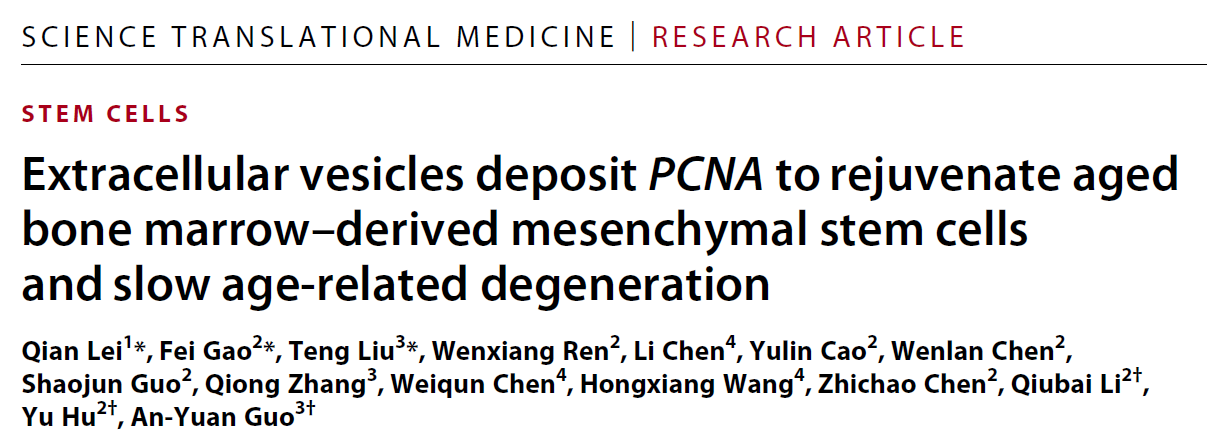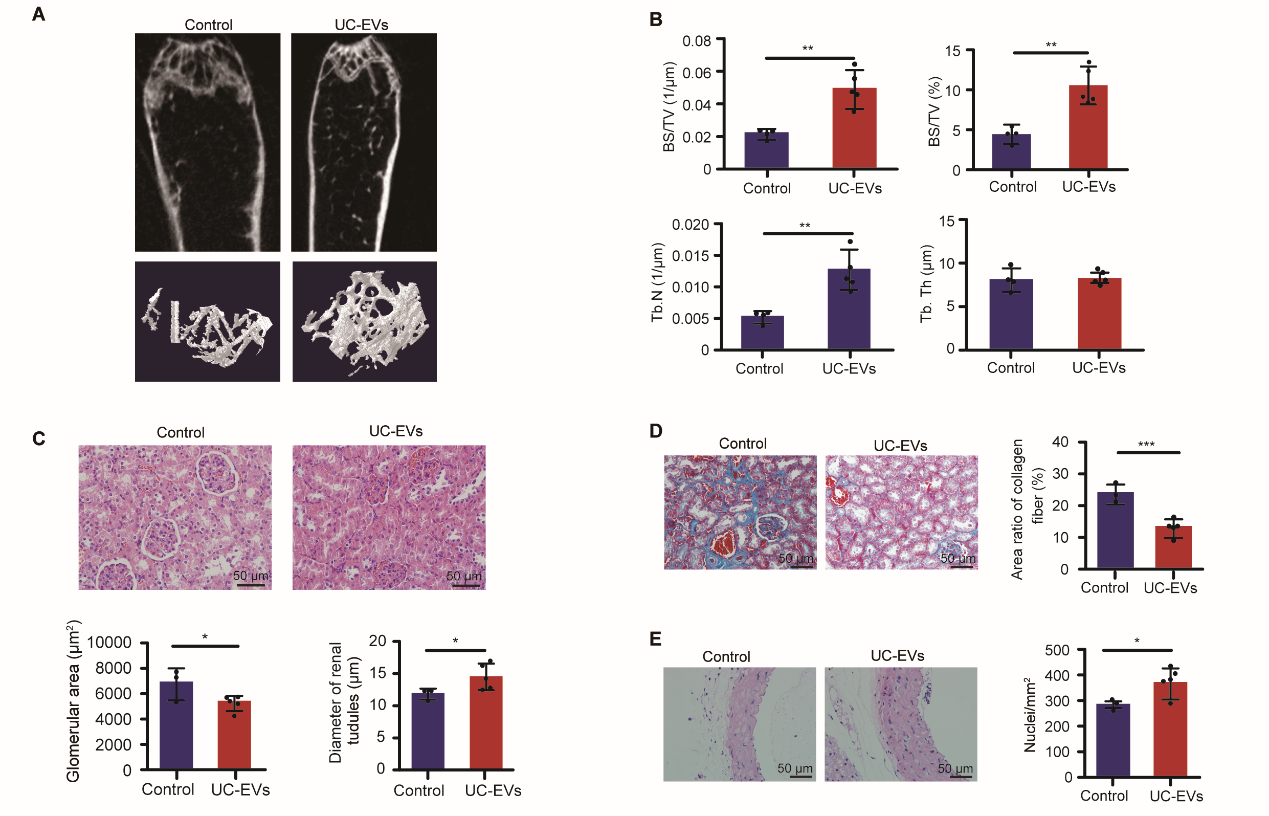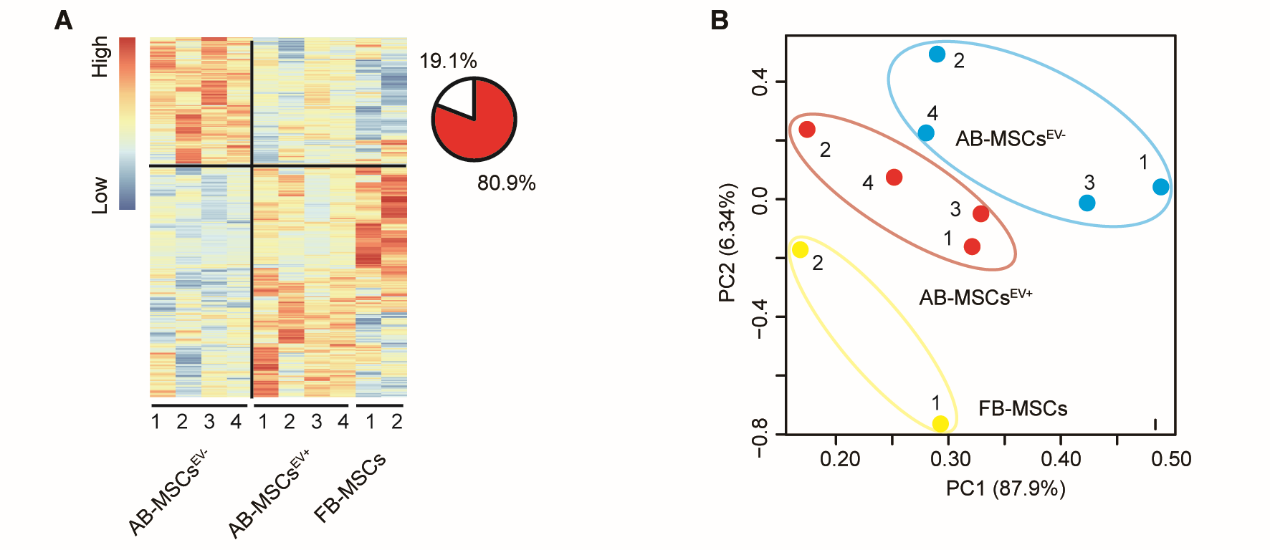Longevity and rejuvenation have been the ultimate dream of human beings since ancient times, and the poet Li Bai once wrote the poem "If I can get the medicine of immortality, I will fly high to Peng Ying". As we grow older, human beings inevitably experience aging. Aging leads to degenerative changes and functional decline of various tissues and organs, and is also a major risk factor for tumors, cardiovascular, cerebrovascular and metabolic diseases and other complex diseases. At the same time, the accelerated aging of human society has made the research on how to slow down or even reverse aging increasingly urgent.
The aging of the organism is mainly due to the aging of stem cells. As a kind of pluripotent stem cells derived from mesoderm, Mesenchymal stem cells (MSCs) are widely distributed in many tissues and organs of the body and have a strong ability of self-renewal and differentiation. The aging of MSCs is a key factor limiting their tissue engineering and cell therapy applications, but more importantly is closely associated with functional degeneration and diminished function of multiple tissues and organs of the organism.

On January 27, 2021, the journal Science Translational Medicine online published a paper from Huazhong University of Science and Technology entitled “Extracellular vesicles deposit PCNA to rejuvenate aged bone marrow- derived mesenchymal stem cells and slow age-related degeneration” [1]. Prof. Guo Anyuan from the College of Life Sciences and Technology of Huazhong University of Science and Technology and Prof. Hu Yu and Prof. Li Qubai from Union Hospital of Tongji Medical College of Huazhong University of Science and Technology are the co-corresponding authors of the article. Dr. Lei Qian, Dr. Gao Fei and Dr. Liu Teng are the co-first authors of the article, which is funded by the National Natural Science Foundation of China under various National Natural Science Foundation of China (NSFC) projects. This study demonstrated that extracellular vesicles (UC-EVs) derived from neonatal umbilical cord MSCs (UC-MSCs) can reverse the aging of adult bone marrow MSCs (AB-MSCs) and significantly enhance the latter's osteogenesis and damage repair capacity; in particular, in vivo application of UC-EVs can significantly delay the aging of naturally aging mice and have significant effects on various tissues and organs such as bone, kidney, and vascular smooth muscle.

UC-EVs ameliorate degenerative changes in the skeleton, kidney, and vascular tissues of naturally aged mice
The researchers found that UC-MSCs have a much higher capacity to secrete EVs than adult bone marrow MSCs, and comparative sequencing and bioinformatics analysis revealed that UC-EVs are rich in cell cycle, DNA replication and repair-related "youth information", and that these UC-EVs significantly improve the proliferation, self-renewal and DNA replication of aging MSCs. The bioinformatics analysis of transcriptome data revealed that UC-EVs enriched with "young information" could make senescent cells show a shift from senescent to young in gene expression, making senescent target cells enriched in cell cycle, DNA replication and repair-related signaling pathways. The reversal effect of UC-EVs is at least partly achieved by horizontal delivery of PCNA, and the specific mechanism of action and downstream effector molecules need to be further investigated.

UC-EVs shift the gene expression pattern of senescent cells toward that of young cells
Starting from extracellular vesicles secreted by young MSCs (of umbilical cord origin), this study confirmed the potent reversal effect of UC-EVs on the senescence of adult bone marrow MSCs at the molecular, cellular and organismal levels through ex vivo experiments. More importantly, this study demonstrated that UC-EVs could delay the aging of naturally aged mice at the overall organism level, especially the degenerative functions of various tissues and organs were significantly altered. Delaying natural aging has important implications for human health and social development in the current increasing aging society. This study provides new ideas and new means with safe translational application for human anti-aging and treatment of aging-related degenerative diseases, and will also open a new broad field for scientific research and high endowment redevelopment application of umbilical cord, which has abundant resources in China.
Prof. Guo Anyuan, professor in the College of Life Sciences and Technology of Huazhong University of Science and Technology, has a long and stable cross-collaboration with the hematology team of Union Hospital in the fields of leukemia and extracellular vesicles. Since 2013, the group has proposed a scientific hypothesis that "young vesicles" (extracellular vesicles secreted from young maternal cells) can reverse the effect of aging by transmitting "youthful information". Since then, the group has continued to conduct in-depth research in this direction, resulting in a number of research results with high translational value. Several papers have been published on miRNA regulatory network in T lymphoblastic leukemia [2], leukemia microvesicle-induced carcinogenesis and its mechanism [3, 4], multiple myeloma microvesicles promoting bone disease and disease progression [5], regulation of lymphocyte differentiation [6], and extracellular vesicle senescence markers in MSC [7], and also established an extracellular vesicle miRNA expression profile database EVmiRNA, etc. [8].
References
1. Lei Q, et al. Extracellular vesicles deposit PCNA to rejuvenate aged bone marrow–derived mesenchymal stem cells and slow age-related degeneration. Science Translational Medicine. 2021 Jan 27; 13(578): eaaz8697
2. Ye H, et al. MicroRNA and transcription factor co-regulatory network analysis reveals miR-19 inhibits CYLD in T-cell acute lymphoblastic leukemia. Nucleic Acids Research. 2012 Jul;40(12):5201-14.
3. Zhu X, et al. BCR-ABL1-positive microvesicles transform normal hematopoietic transplants through genomic instability: implications for donor cell leukemia. Leukemia. 2014 Aug;28(8):1666-75.
4. Zhang HM, et al. miR-146b-5p within BCR-ABL1-Positive Microvesicles Promotes Leukemic Transformation of Hematopoietic Cells. Cancer Research. 2016 May 15;76(10):2901-11.
5. Zhang L, et al. Tumor-derived extracellular vesicles inhibit osteogenesis and exacerbate myeloma bone disease. Theranostics. 2019 Jan 1;9(1):196-209.
6. Lin Y, et al. Transcription factor and miRNA co-regulatory network reveals shared and specific regulators in the development of B cell and T cell. Sci Rep. 2015 Oct 21;5:15215.
7. Lei Q, et al. Microvesicles as Potential Biomarkers for the Identification of Senescence in Human Mesenchymal Stem Cells. Theranostics. 2017 Jul 6;7(10):2673-2689.
8. Liu T, et al. EVmiRNA: a database of miRNA profiling in extracellular vesicles. Nucleic Acids Research. 2019 Jan 8;47(D1):D89-D93.